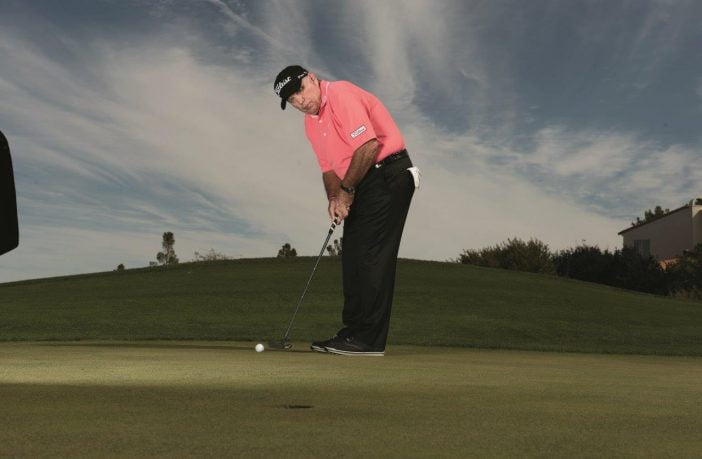3 Tour secrets that’ll get you making putts by Butch Harmon
My dad used to say you can always tell great putters because all their putts have that “going in” look. I love that phrase, and it makes sense when you watch players who can really putt. They give their full effort every time, and they never talk themselves out of a putt. Look at it this way, there are only two things that can happen—you make it, or you miss it—and I can tell you, the best putters only think about one. There’s no reason the average golfer can’t become a great putter. It’s the simplest swing you make; there are no bunkers, no out-of-bounds, no rough; you’re on a perfectly smooth surface, and the target is right there. Still, most golfers have a negative attitude, which I never understand. All you have to do is read the break, aim the face and start the ball on line. And, most important, decide to be positive. Let’s look at a few things I’ve learned from great putters I’ve worked with—and get you dropping more putts. —with Peter Morrice
Phil Mickelson: Develop your feel for distance on long putts
Here’s a drill I’ve watched Phil do over the years to hit putts with great speed. He finds a hole on the practice green and sticks three tees in the ground, at 30, 40 and 50 feet out. His goal is to roll three putts in a row from each tee into an imaginary three-foot circle around the hole. He starts at 40 feet and putts from there until he gets three in a row. Then he goes to 30, then 50—going out of order like this means you can’t just get in a groove.

‘This is Phil’s 30-40-50 drill. Use it to learn distance control, and you’ll stop three-putting.’
Distance control is the big thing on long putts. If you judge the speed right, you’ll almost always have a simple second putt. But if you judge it wrong, you might leave yourself 10 or 12 feet. On long putts, I like the stroke to be a little longer and slower, so you can put some hit on the ball. When most golfers try to hit it harder, they get quick and jabby, which usually causes a mis-hit. You want the putter head to accelerate through the ball, so think long and smooth.
Phil’s drill is a great test. And don’t just practice from one angle. If you start with downhill, right-to-left putts, next time go uphill, left to right. Any 50-foot space will do—even use a water bottle for the hole (above). You’ll quickly see a difference in your distance control.
Brandt Snedeker: Keep the routine short and on point

‘So instead of staring at the ball, track your eyes down your intended line, especially the first foot or two’
Sneds is a great putter for the average golfer to copy because he gets on with it. Once he knows what he wants to do with a putt, he doesn’t waste any time. Taking longer only ups your stress level and invites you to start doubting what you’re doing. If you watch Brandt, you’ll see when he’s reading a putt from behind the ball, he’s often making little air strokes with the right hand. Then, when he steps in, he makes three or four short practice strokes, always looking at the hole. He’s fine-tuning his feel.
His stroke is more of a pop action than what we normally see on the PGA Tour. It has a quicker pace and very little follow through. I putt like that, too, because it helps me hit the ball on the right line. That’s what good putting is all about.
The best lesson here is to keep your focus simple. As you read your putt, imagine a three- or four-inch trough from your ball to the hole. You want to roll your ball down that trough, and that means getting it started online. So instead of staring at the ball, track your eyes down your intended line, especially the first foot or two (below). Then give it a good, firm rap down that line—just like Sneds.
Rickie Fowler: Give yourself a lift

‘Rickie lifts his putter head off the ground right before he putts’
Rickie has become very competent with shorter putts. He ranks fourth on tour from a range of four to eight feet, making 82 percent. The best thing he does to hole these is simple enough for any golfer to adopt: He lifts his putter head off the ground right before he putts. Let’s back up a minute and look at Rickie’s overall approach. I like that he steps into these putts with the clear purpose of getting the putter face aimed precisely.
He’s deliberate about that. In fact, he sets the face with only his right hand and completes his grip when the face is perfect. Then he takes one look at the hole and raises the putter head fractionally off the ground before he starts back.
I want you to try this for two reasons: First, it’ll help take the tension out of your hands and arms, and we all know that tension is a killer on these short ones. Second, it sets up a smooth, even backstroke with no risk of the club getting stuck on the grass. Very clever little move. And just like these other tips, it’ll help you putt like a pro.



